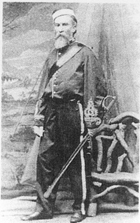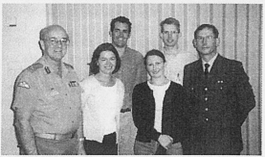Abstract
Military anaesthesia is a key specialty in the Australian Defence Force of the twenty-first century. Currently, some sixty Service anaesthetists, all Reservists within the three Services, form the craft cadre from which all volunteers are drawn for overseas operational deployments. This tradition of volunteer service commenced with the commissioning of Lieutenant John Henry Hill Lewellin (1818-1886) of the Volunteer Force (Rifles) of the Victorian Defence Force in January 1864, and his appointment as Regimental Medical officer of the Prahran and South Yarra Corps. Lewellin was a pioneer anaesthetist and the first to administer an anaesthetic in Scotland (in December 1846), and after his emigration to Australia became a pioneer “etherist” in Melbourne. Lewellin was born in the Fort William Garrison in Calcutta, the son of a cavalry officer of the 24th Light Dragoons. As a doctor-soldier in his later life in Australia, Lewellin became an exemplar of that group of doctors, anaesthetists in this context, who went on to became leaders in the clinical and scientific lives of their communities; and whose volunteer service as specialist doctor-soldiers formed the pivot on which much operational service depends.
Australia’s overseas operations necessitate the provision of Forward Surgical Teams to support the Nation’s servicemen and women in the event of injury or severe illness. Such teams comprise the basic unit of a surgeon and anaesthetist with their supporting clinical team. The twenty-first century has brought great challenges in the provision of such support – particularly in a Defence Force which contains no fulltime specialists.
There has been manifest success of the health deployments on such operations as the Rwandan emergency (UNAMIR 11),1 the Sepik tsunami of July 1998,2 the Peace Monitoring Group in Bougainville from 1997 and the deployments to East Timor (INTERFET and UNTAET) from September 1999. Currently, some 60 Service anaesthetists comprise the specialty cadre who maintain and develop the intellectual property of the specialty of military anaesthesia in Australia. Such men and women continue a tradition of altruistic volunteer service started more than 150 years previously when one of Australia’s pioneer “etherists” was commissioned as a doctor-soldier in the Victorian Defence Force. He was Lieutenant John Henry Hill Lewellin (1816-1886). A pioneer Australian anaesthetist and military surgeon who was to become a patron of science in his adopted land. His pioneering role in clinical anaesthesia and his Reserve military service comprise another example of the origins of volunteer specialist medical service as a key element in the Nation’s defence.
John Henry Hill Lewellln (1818-1886)
John Henry Hill Lewellin’s entire life was linked with the army and with medicine. Literally a “son of the Regiment”. He was born in the cavalry lines of the military Fort William Garrison in Calcutta.3 His father, Henry Lewellin, had joined the British Army in August 1807; and had been appointed to the 24th Regiment of Foot with the rank of Ensign (Second Lieutenant). He was promoted to the rank of cavalry Lieutenant in the 24th Light Dragoons in 1811. He died on the 11th October 1820, when his young son, the future pioneer soldier anaesthetist in Australia, was but two years of age.
The fatherless boy, John Henry Hill Lewellin, grew up in the military fortress of Fort William, on the banks of the Hooghli River. The garrison had its base in the Old Fort, built in the 17th century, to protect British traders from attacks by the Nabob of Bengal; and was rebuilt in 1781 as a base and training centre for British troops.5
The period prior to the Indian Mutiny was the era when an expatriate British surgeon in India, Dr James Esdaile, was promoting the use of hypnotism – which he called mesmeric trances – as a form of analgesia.6 It is probable, but unconfirmed, that the future pioneer Australian military anaesthetist was influenced by the potential of achieving a more humane pain reduction for those undergoing surgical operations.
In 1842 Lewellin emigrated to England and studied at St Bartholomew’s Hospital in the academic year of 1842-18437. He was admitted as a Member of the Royal College of Surgeons of London on 8th April 1842 and thereafter practised in Glasgow. The first published cases of surgical anaesthesia, by the Boston dentist, Dr William Morton, were recorded on October 16th, 1846. Dr John Lewellin was the first to use ether in Glasgow, on the 4th January 1847. He demonstrated its use before a group of medical colleagues (and the patient’s friends!) in the extraction of a carious molar tooth.7.8 Lewellin disappeared from Glasgow after June 1847 and his whereabouts for the ensuing five years remain tantilisingly unknown. He reappeared in Australia in September 1852, on the Bengal Merchant, a three-masted teak ship which had sailed from London on the 1st April 1852. Lewellin was registered as a Medical Practitioner on the Medical Register of Victoria from 1854, and he remained as a registered Medical Practitioner until his death in 1886.
Lewellin developed a particular reputation in oral surgery, and on occasions advertised as a dentist. One of his particularly spectacular successes was the support and cure of a 12-year-old boy with tetanus, whom he treated with aconite and with intermittent chloroform anaesthesia.10 He administered intermittent chloroform anaesthesia for the tetanic spasms with great frequency over the ensuing period of three weeks. Lewellin advocated the use of chloroform particularly to prevent risus sardonicus, the distressing and potentially painful lockjaw which forms part of the dramatic clinical syndrome of generalised tetanic spasms with opisthotonus – a sign which usually presaged death; and which was so typical of the disease in those years before the generalised use of muscle relaxants became widespread.
Lewellin became a leader in the Melbourne community of his day. He served as a Magistrate; and was also appointed as Vaccination Officer. He loved science and became a patron of science and supporter of one of Australia’s most decorated scientists, the Melbourne botanist, Ferdinand von Mueller. Mueller was todedicate a volume of his best-known work, Fragmenta phytographiae Australia to his doctor-anaesthetist friend, inscribing in the frontispiece “To my friend Henry Lewellin, a most skilful Physician”8. Dr Lewellin was a vigorous member of the Medical Society of Victoria; from 1856 his name appeared in many reports of the activity of that Society. He delivered clinical papers on acute dysentery 11 and on pneumothorax.12
He worked as a clinician until he sustained a stroke in October 1886 and died three years later at East St Kilda, aged 68 years.
A Pioneer Soldier-Anaesthetist
Lewellin was one of the world’s pioneer soldier-anaesthetists. Like a number of medical colonists, he fused his clinical and technical interests with those of altruistic, volunteer public service. He was to be a forerunner of the Reserve Service anaesthetists who provide the essential clinical skills, which is a sine qua non of all overseas operational deployments today.
In January 1864, Lewellin was commissioned with the rank of Lieutenant, and was appointed Assistant Surgeon in the Victorian Volunteer Force (Rifles). He was posted as a Regimental Medical Officer to the Prahran and South Yarra Corps in Melbourne. His military career followed the progression which was to become so common in the ensuing century. In April 1867 he was promoted to the rank of Captain, and by 1878 had been promoted to Major.
The only known surviving photograph of Lewellin (Figure 1), is one of him in his full military uniform, showing the accoutrements of an Australian colonial surgeon of his day. He bore the straight infantry officer’s sword with the hilt device of Queen Victoria’s cypher. The backdrop of that photograph, in the studio of Thomas Ferris of Chapel Street, Prahran (from circa 1868), portrays a painted scene of the Yarra River with a tented encampment on its southern banks.

Figure 1: Surgeon Captain John Henry Hill Lewellin (1818-1886), Australia’s first military anaesthetist. His appointment as Assistant Surgeon of the Prahran and South Yarra Corps of the Victorian Defence Force in January 1864 began a tradition which was to continue and be developed by many hundreds of Reserve Military anaesthetists over the ensuing one hundred and fifty years in Australia. This photograph is from a carte de visite, from the personal photograph album of the Melbourne botanist and scientist. Ferdinand von Mueller, the latter one of Australia’s most decorated scientists. Von Mueller entitled this photograph, the only extant one of Lewellin, “J.H.H. Lewellin, Surgeon Southern Rifles”. Photograph originally taken by Thomas Ferris, commercial photographers of Chapel Street, Prahran, circa 1868. Courtesy of Mrs Doris Sinkora of the National Herbarium of Victoria, with acknowledgements.
Conclusion
One hundred and fifty years after the invention of anaesthesia, the first two Australian National Workshops on Military Anaesthesia was held in Launceston on the 23rd – 24th and the 30th – 31st March 2000.

Figure 2: The youth face of Australian military anaesthesia. At centre are four anaesthetists-in-training within the Defence Health Service, the Australian Defence Force – students in the second National Workshop of Military Anaesthesia held in Australia; conducted at the Department of Anaesthetics, Launceston General Hospital, Tasmania, 30th – 31st March 2000.
Front row (left to right): Major General John Fearn AM RFD, the Surgeon General, Australian Defence Force; Fit Lt Tanya Casey; Lt Kate Shea; Wing Commander George Merridew, consultant anaesthetist and National Workshop Co-Convenor and Co-Ordinator.
Rear Row: Captain John Stedman RAAMC; Sqn Ldr Tony Keeble. Photograph, Launceston General Hospital, 31st March 2000.
This city was a most appropriate choice of the Convenor. Wing Commander George Merridew, as it was in Launceston that Dr William Russ Pugh in 1847 conducted the first surgical anaesthesia in Australia. Those one hundred and fifty years have seen an unprecedented evolution in the development of anaesthestic pharmacology, of instrumentation. of policies and of safety doctrine. Some things, however, remain unchanged. The pioneer etherists in Australia Belisario13, Pugh14.15, Buchanan13 and Lewellin7.9 – exhibited those qualities which in colonial times were indispensible for the early development of a new discipline. Those qualities included deft technical dexterity a flair for improvisation, resilience, courage and a flair for innovation. Such qualities remain the indispensable ingredients of military anaesthesia today just as they did in Lewellin’s time.






